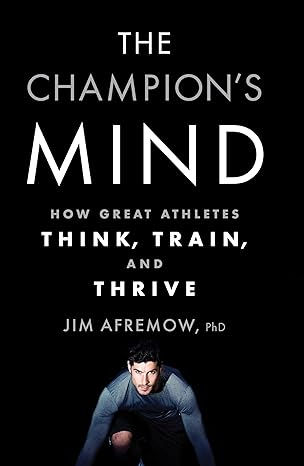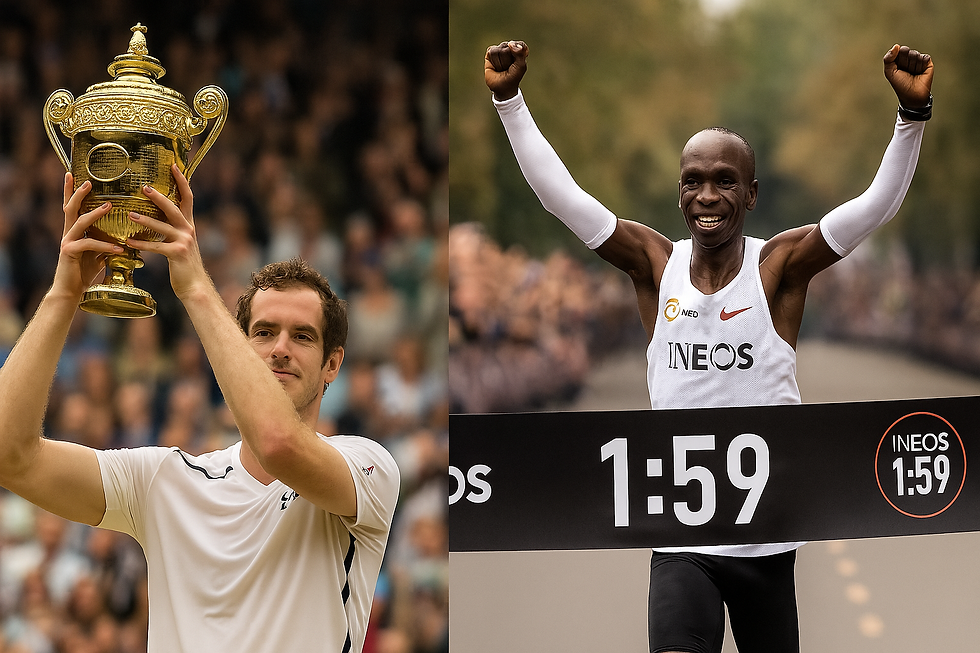Wimbledon Secrets to Mental Toughness Every Runner Needs to Know
- Nathan Rose
- Jul 11
- 6 min read
Updated: Jul 15
“The difference between winning and losing is most often not quitting.” – Walt Disney
Each summer, Wimbledon reminds us of sport at its most demanding and inspiring. Beyond the iconic grass courts and white attire, what unfolds is a mental duel—players rally not only against their opponents but also against self-doubt, pressure, and fatigue.
As runners, we may not be facing a serve at 130 mph, but our sport tests the mind in its own quiet, relentless way. Whether pushing through a tempo run or hitting the wall in mile 20 of a marathon, runners battle many of the same psychological demons. And this is where tennis—particularly Wimbledon—has surprising lessons to teach us.
The Mental Demands of Wimbledon
Wimbledon isn’t just a tennis tournament—it’s a psychological battleground. The surface alone—grass—introduces unpredictability that demands adaptability and poise. A ball might skid lower than expected or bounce irregularly off worn patches. Matches stretch for hours, sometimes spilling over into the next day due to rain delays. The mental load is relentless.
Players must deal with national expectations, the looming gaze of Centre Court, and the internal voice whispering doubt. They often succeed not by playing their best tennis, but by playing their most mentally resilient game.
That resilience—the ability to reset after losing a set, to stay composed after double-faulting on break point—is what separates the great from the good.

Running: The Quiet Battle
Running often presents itself as a solo pursuit, absent of a physical opponent. But the mind plays a central role: questioning your ability, exaggerating your fatigue, urging you to quit. Runners frequently wrestle with:
Pre-race nerves that sabotage sleep the night before
Mid-run fatigue that clouds judgment and ruins pacing
Post-run disappointment after a bad session
Injury-induced fear and frustration
Like elite tennis players, runners must learn to master their inner world. And the more pressure we feel—be it from a personal best attempt or our own expectations—the more crucial that mastery becomes.
Learning from Tennis: 6 Lessons Runners Can Use
Let’s explore six Wimbledon-tested mental toughness principles and how they apply directly to runners.
1. Pressure Is a Privilege
Billie Jean King famously said, “Pressure is a privilege—it only comes to those who earn it.” Wimbledon players step into pressure-filled situations every time they serve at 5-5 in the final set. They’ve trained not only their strokes, but their ability to stay calm and focused when everything’s on the line.
Runners, too, face pressure—lining up at a start line, pushing through pain in the final mile, or chasing a new personal record. Instead of fearing these moments, we can reframe them: pressure means you’re doing something meaningful. You’re testing limits. You’re alive in the challenge.

Check out this fantastic book, The Champion’s Mind by Jim Afremow—a must-read guide for athletes looking to master pressure and self-talk.
2. Bounce Back Faster
Watch Novak Djokovic lose a tight tiebreak, and you’ll rarely see him spiral. Instead, he bounces on his toes, adjusts his strings, and resets. The point is over. The match continues.
Runners can take a page out of this book. A missed PR, a poor workout, or a DNF is not a career-ending event. It’s one chapter in a much larger training story. The faster you mentally reset, the less damage you'll do to your motivation and momentum.
If you bomb a long run, reflect on what happened—but don’t ruminate. Did you sleep poorly? Was hydration off? Learn and move on. Like a tennis player who drops a set, you still have more to give.

Recovery also includes physical tools. Try a TriggerPoint foam roller to bounce back physically while you reset mentally.
3. Rituals Reduce Chaos
Rafael Nadal’s court rituals are infamous—towel touch, hair tuck, bottle placement—but these aren’t about superstition. They’re about focus. In a high-stakes environment, routine offers control, consistency, and comfort.
Runners benefit from rituals too. A pre-run routine can help shift your mindset from distracted to determined. Maybe it’s lacing up your shoes the same way, sipping a specific hydration mix, or listening to a power playlist.
Before a race, consistent rituals lower stress and sharpen focus. Even something as simple as a pre-race mantra can help block out distractions and focus your mind on performance.
Looking for that “locked-in” feeling pre-run? Try Liquid I.V. hydration packets—great for race mornings or hot summer training.
4. Endure the Mental Distance
A 5-set Wimbledon final is a marathon in disguise. It tests stamina, concentration, and emotional fortitude. And much like the last miles of a marathon, the fifth set is often where champions emerge.
Running distances like half marathons or full marathons aren’t just physically grueling—they’re mentally depleting. You hit a wall, your legs revolt, and your mind begs you to quit. That’s where mental endurance becomes your biggest ally.
Kipchoge’s serene face during his sub-2 marathon attempt wasn’t just the result of physical fitness—it was a testament to his mental calm. He embodied the same poise Wimbledon legends carry into sudden-death tiebreaks.
Mental Training Tips:
Use short, rhythmic mantras (“Smooth and strong”) to stay focused.
Break your run into segments; don’t run 26.2 miles—run 10K, then another, then 10K more.
Train your attention: focus on breath, form, surroundings—get out of your head.

Train your focus on long runs with AfterShokz bone-conduction headphones – stay present with music or guided run audio without tuning out your body.
5. Embrace the Discomfort, Don’t Fight It
Tennis players grow used to discomfort—not just physical pain, but emotional unease: nerves, momentum shifts, tight games. Wimbledon’s grass courts amplify unpredictability. Embracing this discomfort is part of their success.
For runners, discomfort often triggers panic: heart rate spikes, legs feel heavy, mind spins into negativity. But discomfort isn’t danger. It’s data. It’s your body asking, “Can we keep going?”
Instead of fighting the discomfort, invite it in. Treat it like a weather change—not ideal, but manageable.
This mindset takes practice. Start with tempo runs. Learn to sit with the burn. Practice breathing into tension. Watch your thoughts, but don’t believe them all.
Enhance recovery and manage discomfort with Magnesium muscle soaks—great after hard sessions or races.
6. Stay in the Moment
Wimbledon champions often say the secret is “point by point.” They don’t dwell on missed shots or worry about the next set. They play what’s in front of them—this ball, this serve, this swing.
Running demands the same presence. You don’t run a marathon by worrying about mile 20 at mile 3. You stay in the current stride. The present breath. The immediate decision.
Mindfulness isn’t just a buzzword—it’s a training tool. Studies show athletes who stay in the moment experience less perceived effort and more positive performance outcomes.
Consider integrating short, guided mindfulness sessions into your weekly routine—even 10 minutes of breath-led stillness can improve focus and emotional control.
Real Inspiration: Tennis and Running Legends
In 2013, Andy Murray carried the weight of a nation when he won Wimbledon—becoming the first British man in 77 years to do so. His tears afterward weren’t just relief—they were release after years of pressure and perseverance.
Runners can relate. Whether it’s qualifying for Boston or finishing your first 5K, your journey is shaped as much by mental persistence as physical prep.
In contrast, consider Eliud Kipchoge’s iconic sub-2-hour marathon. His mantra? “No human is limited.” Like Federer’s grace or Serena’s grit, Kipchoge’s calm confidence was a product of relentless mental training.

Final Thoughts: From Centre Court to Starting Line
Wimbledon teaches us that greatness isn’t just about power or precision—it’s about poise. Tennis players spend years mastering the art of pressure, presence, and recovery. As runners, we train our bodies, but often neglect the mind.
It’s time we change that.
By embracing discomfort, staying present, developing rituals, and reframing pressure, we can run with more resilience. Whether you’re chasing a podium finish or your own sense of personal victory, mental toughness will carry you farther than any training plan alone.
Next time you step to the starting line, imagine you’re stepping onto Centre Court. Breathe. Focus. And trust your training.
Game. Set. Run.
Suggested Tools to Build Mental Strength
🧠 The Champion’s Mind by Jim Afremow
📖 The Inner Game of Tennis – a must-read for runners, too
Just a Heads Up!
Hey, heads up! Some of the links on this page are affiliate links. That means if you click one and snag something awesome, I might earn a little commission — at zero extra cost to you. It’s like your way of saying thanks for the recommendations and helps me keep sharing cool stuff with you. Win-win, right?









Comments